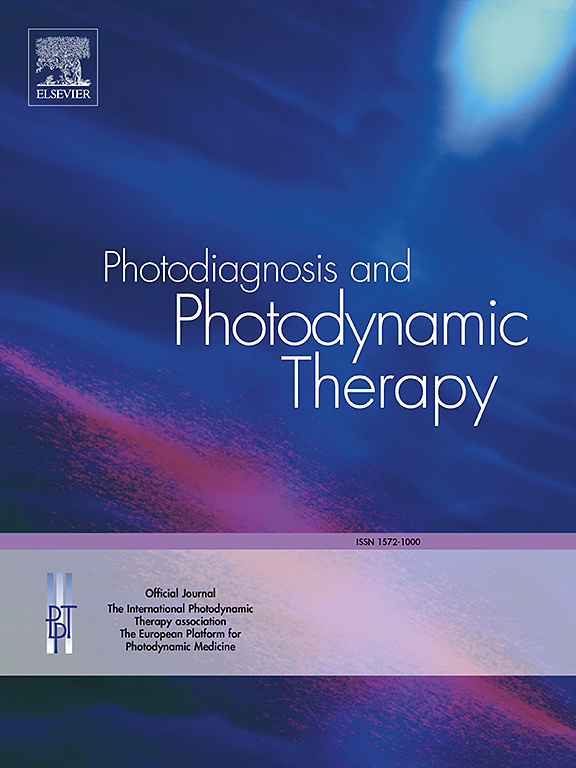应用自适应光学和显微视野法评估手术封闭黄斑孔患者的光感受器恢复和视觉功能。
IF 3.1
3区 医学
Q2 ONCOLOGY
引用次数: 0
摘要
背景:本研究探讨了闭合性黄斑孔(MHs)手术患者的光感受器结构恢复与视觉功能预后的关系。采用自适应光学扫描激光检眼镜(AOSLO)和显微验光术,我们旨在提供更详细的了解光感受器的恢复和视力的改善。方法:对28例玻璃体切除术合并内限制膜剥离治疗特发性MHs患者的31只眼进行回顾性观察研究。术后3个月至2年监测视觉和结构结果:最佳矫正视力(BCVA)、MH直径和持续时间、光学相干断层扫描(OCT)图像、4°视网膜平均灵敏度(RMS)、固定率、显微镜检68.2% BCEA(二元轮廓椭圆面积)和AOSLO测量的锥体密度。根据OCT检查结果,将患者分为两组:1型(闭合性MH,无中央凹神经感觉缺损)和2型(闭合性MH,有中央凹神经感觉缺损)。结果:分析显示,1型闭合明显改善了光感受器的恢复,视锥细胞向中央凹迁移并形成致密的胰岛,与oct内节/外节层的完整性一致。这些患者术后BCVA更好,RMS更高,而不是固定改善,与视锥密度的改善一致。相比之下,2型闭包呈现稀疏的锥体分布和大而高密度的细胞,可能表明胶质细胞增殖和暴露的视网膜色素上皮(RPE)。MH大小,而不是持续时间或术前BCVA,是1型闭合结果的关键决定因素。结论:AOSLO是评估MHs显微结构愈合的一种有价值的工具,它揭示了以锥体迁移为特征的1型闭合导致更大的神经视网膜修复,改善BCVA和视网膜敏感性。同时,2型闭包,以较少的光感受器恢复和较高的胶质细胞增殖为特征,对应于较差的视觉功能结果。本研究强调了光感受器密度和迁移在MH闭合术后实现最佳视觉功能中的作用。本文章由计算机程序翻译,如有差异,请以英文原文为准。
Assessment of photoreceptor recovery and visual function utilizing adaptive optics and microperimetry in patients with surgically closed macular holes
Background
This study investigated the association between photoreceptor structural restoration and visual function outcomes in patients undergoing surgery for closed macular holes (MHs). Using adaptive optics scanning laser ophthalmoscopy (AOSLO) and microperimetry, we aimed to provide a more detailed understanding of photoreceptor recovery and visual improvement in closed MHs.
Methods
We conducted a retrospective observational study of 31 eyes of 28 patients who underwent vitrectomy with internal limiting membrane (ILM) peeling to treat idiopathic MHs. Visual and structural outcomes were monitored 3 months to 2 years postoperatively: best-corrected visual acuity (BCVA), MH diameter and duration, optical coherence tomography (OCT) images, 4° retinal mean sensitivity (RMS), fixation rates, 68.2 % BCEA (binary contour ellipse area) of microperimetry, and cone density as measured by AOSLO. Based on the OCT findings, the patients were categorized into two groups: type 1 (closed MH with no neurosensory defect at the fovea) and type 2 (closed MH with a foveal neurosensory defect).
Results
The analysis revealed that type 1 closures resulted in significantly better photoreceptor recovery, with cone cells migrating toward the fovea and forming dense islets, consistent with the integrity of the inner segment/outer segment layer on OCT. These patients also had better postoperative BCVA and higher RMS rather than fixation improvement, aligning with the improved cone density. In contrast, type 2 closures exhibited sparse cone distribution and a prevalence of large, high-density cells, possibly indicating glial cell proliferation and exposed retinal pigment epithelium (RPE). MH size, rather than duration or preoperative BCVA, was a key determinant of type 1 closure outcomes.
Conclusion
AOSLO is a valuable tool for evaluating microstructural healing in MHs and reveals that type 1 closure, characterized by cone migration, leads to greater neuroretinal repair and improved BCVA and retinal sensitivity. Meanwhile, type 2 closures, marked by less photoreceptor recovery and higher glial proliferation, correspond to poorer visual function outcomes. This study highlights the role of photoreceptor density and migration in achieving optimal visual function post-surgery for MH closure.
求助全文
通过发布文献求助,成功后即可免费获取论文全文。
去求助
来源期刊

Photodiagnosis and Photodynamic Therapy
ONCOLOGY-
CiteScore
5.80
自引率
24.20%
发文量
509
审稿时长
50 days
期刊介绍:
Photodiagnosis and Photodynamic Therapy is an international journal for the dissemination of scientific knowledge and clinical developments of Photodiagnosis and Photodynamic Therapy in all medical specialties. The journal publishes original articles, review articles, case presentations, "how-to-do-it" articles, Letters to the Editor, short communications and relevant images with short descriptions. All submitted material is subject to a strict peer-review process.
 求助内容:
求助内容: 应助结果提醒方式:
应助结果提醒方式:


